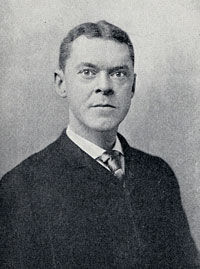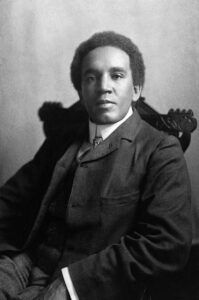Intimacy at the Schermerhorn
Foote and Coleridge-Taylor Quintets
The Nashville Symphony presented a Chamber Music Series this season to provide more intimate and informal concerts for the audience in Music City. The musicians would speak between each piece, providing information about the composer and pieces being performed. At the end of the concert, they also offered an exciting Q&A session to learn more about the musicians.

On Tuesday evening, October 29, they showcased the “Late Romantics Quintet.” They presented “Nocturne and Scherzo, Movements I and II” by Arthur Foote and “Quintet in F-Sharp Minor, Op. 10” by Samuel Coleridge-Taylor. Musicians who performed included Anna Lisa Hoepfinger (violin), Johna Smith (violin), Daniel Reinker (viola), Keith Nicholas (cello), Leslie Fagan (flute), and Katherine Kohler (clarinet).
Before the first piece started, Anna Lisa Hoepfinger spoke a little about Arthur Foote and the piece about to be performed. Arthur Foote was part of the Boston Six, and Hoepfinger brought up a performance that they did of Amy Beach’s piece, since she was also part of the Boston Six, suggesting influences of Beach in Foote’s piece. Hoepfinger also stated that “Norturno” could be performed as a stand-alone, but they decided to perform both movements. This piece featured flute, so Leslie Fagan completed the group as the fifth musician on stage. The first movement is titled “Nocturno” or “Night Music,” and when they started this movement, the blend between each instrument was luscious, with the flute peaking over the strings when given the melody. Fagan’s playing was almost mesmerizing as she flowed between phrases and kept such a delicate and sweet tone. Then we entered the Scherzo, the next movement in this piece. The musicians captured its characteristics with very light and cheerful playing. I was impressed with how closely they matched articulations as each tried to bring out these characteristics.

The next piece, “Quintet in F-Sharp Minor, Op. 10,” was by British composer Samuel Coleridge-Taylor. He composed this piece at nineteen years old and included a bit of African spiritual influences within the rhythms. The first movement, titled “allegro-energico” held a folk-like melody that Kohler on clarinet, played beautifully. Her tone was very full and warm with the cellist, Nicholas, who brought a gorgeous and resonant tone that was maintained into the second movement. Hoepfinger also did an amazing job with her electric playing as she glided her bow through the melodic lines. While listening and watching them perform this movement, it was evident how lively it felt among these performers and throughout the audience as they progressed through it. It was a great introduction to the piece.
The second movement, “Larghetto affecttuoso,” was another incredible movement. This movement sounded very familiar to me, and it was by surprise that Coleridge-Taylor drew much inspiration from Antonín Dvořák, so some may believe it sounded similar to Dvořák’s New World Symphony. It was lyrical and graceful as it pushes and pulls the audience into enchantment. When Kohler played within the higher register, she still brought a very light and delicate sound, almost glass-like. The blend between the cellist, and violist, Nicholas and Reinker, expressed a darker tone that complimented the warmness of the clarinet. There was such gorgeous playing among all the performers.
The following two movements: “III. Scherzo. Allegro Leggiero” and “IV. Finale. Allegro” were also very lovely to listen to. The Scherzo was started off by mainly the cello with its resonant down bows. It led the audience into the main melodic theme that the clarinet took over with her clean and rich sound. The violinists, Hoepfinger and Smith both had moments with Nicholas’ cello where they traded the melody back and forth to add on to the playful nature of the first section of this movement. The movement later led into a sing-song melodic part that the clarinetist did a wonderful job with in her melodious lines, moving quite beautifully between phrases. It sounded dreamlike and romantic as the theme of the quintet suggests. It then ends on the same rhythmic section that it started with returning back to the main theme, but with added energy.
The finale was very dramatic. The main theme of this movement starts off with an intense build up of the melodic line with an increase in dynamics and heavier articulations. This folk-like melody echos throughout each instrument, starting with clarinet and trading off to the violins later to the cello and viola. Near the end of this movement, a repeat of the theme from movement two came through. Parts of the blend between the clarinet and strings made it almost sound like the music was singing to the audience. It demonstrated great contrast between the heavier sounding folk-like theme and the melodious singing. As it finished, there were lots of syncopated rhythms lengthening that tension and then releasing it as it moves into quarter and whole notes at the end.
Their entire performance of the two pieces was outstanding. They allowed the pieces to be filled with life and created a night filled with an exciting and captivating energy. Especially with Coleridge-Taylor’s piece, I am obsessed with his compositions and how he utilizes these folk melodies. It was a fantastic night and I hope everyone can come listen to more music from their chamber series. You will leave learning more about the composers and more about the musicians performing these pieces. Thank you so much to the Nashville Symphony for inviting us to come listen to their chamber group!
- About the Author
- Latest Posts
Christina Vongsiharath was born and raised in Murfreesboro, TN, and attends Middle Tennessee State University, majoring in Music Industry and minoring in Finance. She loves performing and is a clarinetist with MTSU’s Wind Ensemble and Clarinet Choir. She also plays the erhu (Chinese fiddle) and is a part of MTSU’s Chinese Music Ensemble. After she graduates, she plans on attending graduate school for ethnomusicology and wants to become a professor teaching students about non-western instruments.



